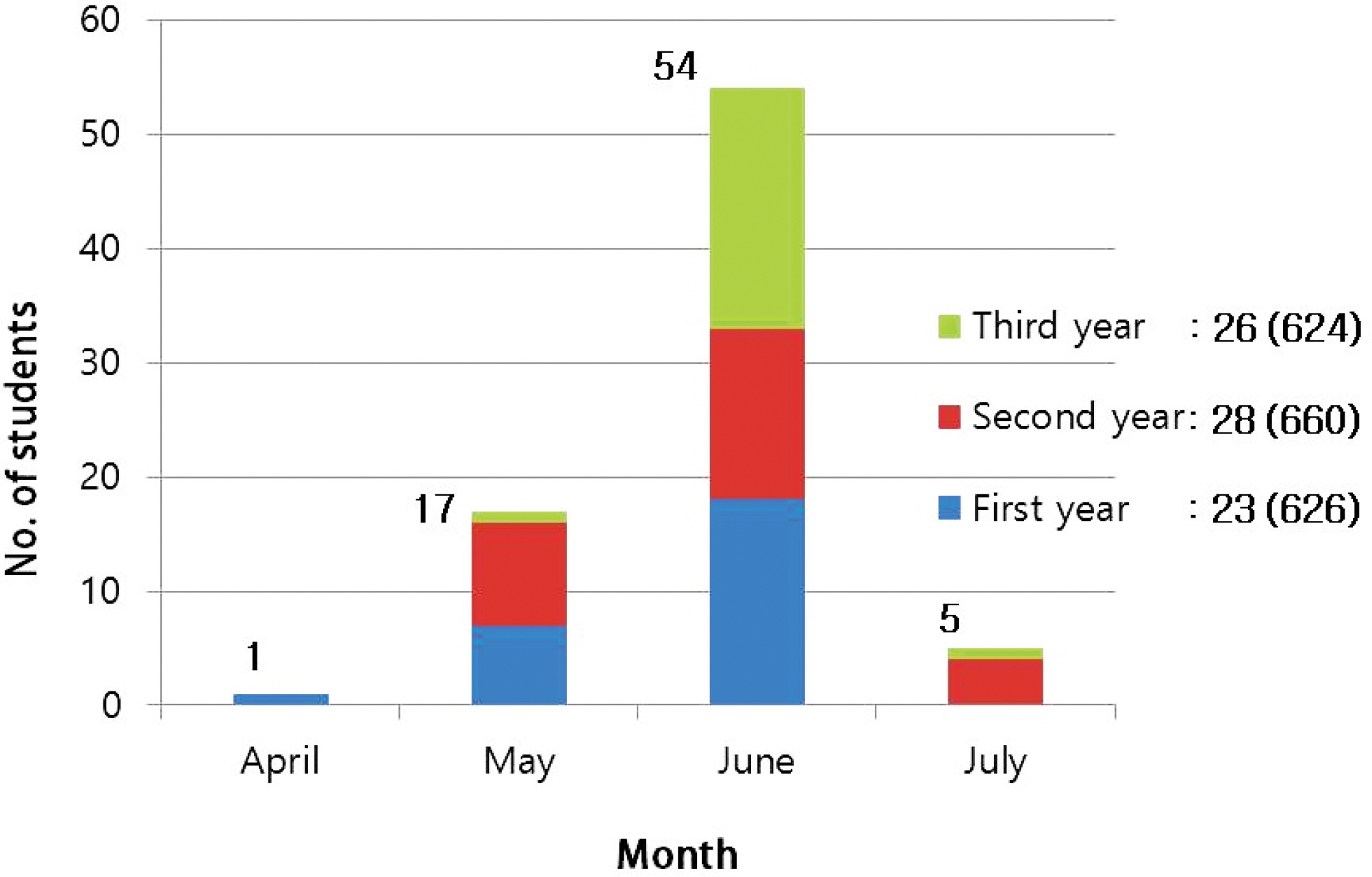Pediatr Infect Vaccine.
2015 Apr;22(1):1-6. 10.14776/piv.2015.22.1.1.
An Outbreak of Mumps in a High School, Seoul, 2013
- Affiliations
-
- 1Department of Pediatrics, Eulji General Hospital, Seoul, Republic of Korea. acet0125@eulji.ac.kr
- 2Department of Pediatrics, Eulji University School of Medicine, Daejeon, Republic of Korea.
- 3Nowon-Gu Health Care Center, Seoul, Republic of Korea.
- 4Division of Respiratory Viruses, Korea National Institute of Health, Centers for Disease Control & Prevention, Chungcheongbuk-do, Republic of Korea.
- KMID: 1791510
- DOI: http://doi.org/10.14776/piv.2015.22.1.1
Abstract
- PURPOSE
This study investigated an outbreak of mumps affecting students in a high school (S high school) in Seoul, with an evaluation of the diagnostic utility of the mumps polymerase chain reaction (PCR) assay.
METHODS
S high school students that presented to health care providers with mumps symptoms between April 2013 and July 2013 were surveyed for the monthly distribution of symptom onset and their grade level. Mumps PCR assays were performed using buccal swabs from some of these students.
RESULTS
During the survey period, 77 students presented with suspected cases of mumps. The monthly distribution of symptom onset was as follows: one in April, 17 in May, 54 in June, and five in July. With regard to grade level, 26 students were in their first year, 28 were in their second year, and 23 were in their third year. Of the 18 students tested with PCR assays, five had positive results. Samples were collected within 3 days of symptom onset in 15 of the 18 students, and positive PCR results were obtained in five of these 15 students. The PCR results of the remaining three students from whom samples were collected more than 3 days after the onset of symptoms were negative (P=0.24).
CONCLUSIONS
We evaluated the epidemiological aspects of an outbreak of mumps in a high school. Mumps PCR might be epidemiologically useful if performed within 3 days of the onset of symptoms in suspected cases.
Keyword
Figure
Reference
-
1. Manson WH. Mumps. In:. Kliegman R, Nelson WE, editors. editors.Nelson textbook of pediatrics. 19th ed.Philadelphia, PA: Elsevier/Saunders;2011. p. 1078–81.2. The Korean Pediatric Society. Measles.Mumps'Rubella. Lee H], editor. Immunization guideline. 7th ed.Seoul: The Korean Pediatric Society;2006. p. 92–108.3. MacDonald N, Hatchette T, Elkout L, Sarwal S. Mumps is back: why is mumps eradication not working? In: N. Curtis et a1, (Ed.) Hot topics in infection and immunity in children VII. Springer, New York;2006. p. 197–220.4. Greenland K, Whelan I, Fanoy E, Borgert M, Hulshof K, Yap KB, et al. Mumps outbreak among vaccinated university students associated with a large party, the Netherlands, 2010. Vaccine. 2012; 30:4676–80.
Article5. Anis E, Grotto 1, Moerman L, Warshavsky B, Slater PE, Lev B. Mumps outbreak in Israel's highly vaccinated society: are two doses enough. Epidemiol and Infect. 2012; 140:439–46.
Article6. Rota IS, Rosen IB, D011 MK, McNall R], McGrew M, Wil— liams N, et al. Comparison of the sensitivity of laboratory diagnostic methods from a well-characterized outbreak of mumps in New York city in 2009. Clin Vaccine Immunol. 2013; 20:391–6.
Article7. Centers for Disease Control and Prevention. Mumps outbreak on a university campus—California, 2011. Morb Mortality Weekly Report. 2012; 61:986–9.8. Dayan GH, Quinlisk MP, Parker AA, Barskey AE, Harris ML, Schwartz IM. Recent resurgence of mumps in the United states. N Engl I Med. 2008; 358:1580–9.
Article9. Kim KH. Reemerging 01d infectious diseases: diagnosis of measles, mumps, rubella, and pertussis. Korean I Pediatr Infect Dis. 2013; 20:115–22.10. Park DW, Nam MH, Kim IY, Kim HI, Sohn IW, Cho Y, et al. Mumps outbreak in a highly vaccinated school pop—ulation: assessment of secondary vaccine failure using IgG avidity measurements. Vaccine. 2007; 25:4665–70.
Article11. Cho SY, Lee SY, Kang IH, Hwang HS. Mumps outbreak in Incheon, Korea, 2009. Korean I of Pediatr. 2010; 53:67.
Article12. Kim KH, Kim CH, Choi BY, G0 UY, Lee DH, Ki M. Mumps transmission control status and inapparent infection rate among middle and high school students during the 2007-2008 mumps outbreak in Daegu. I Prev Med Public Health. 2009; 42:408–15.
Article13. Korea Centers for Disease Control & Prevention. Infectious Diseases Surveillance Yearbook, 2013. Public Health Weekly Report. 2014; 6279-81:Available at. http://www.cdc.g0.kr/CDC/info/CchrInf00302.jsp?menu1ds=HOME001-MNU1132-MNU1138-MNU0038&fid=32&q_type=&q_value:&cid=27068&pageNum=.14. American Academy of Pediatrics. Mumps. Pickering LK, Baker CI, Kimberlin DW, Long SS, editors. editors.Red Book: 2012 Report of the Committee on Infectious Diseases. 29th ed.Elk Grove Village, IL: American Academy of Pediatrics;2006. p. 514–8.15. Korea Centers for Disease Control & Prevention. Division of VPD control 81 NIP Korea. Available at. http://cdc.go.kr/CDC/intr0/CchrIntr00201.jsp?menuIds=HOME001-MNUl154-MNU0005-MNU0011&Cid=21959.16. Peltola H, Kulkarni PS, Kapre SV, Paunio M, Iadhav SS, Dhere RM. Mumps outbreaks in Canada and the United States: time for new thinking on mumps vaccines. Clin Infect Dis. 2007; 45:459–66.
Article17. Choi BY, Kim CH, Ki M, Lee SY, Kim CH, Kang C, et al. Development of goal and strategy of mumps vaccination program. Korea Centers for Disease Control and Prevention. 2005.18. Ogbuanu IU, Kutty PK, Hudson IM, Blog D, Abedi GR, Goodell S, et al. Impact of a third dose of measles—mumps- rubella vaccine on a mumps outbreak. Pediatrics. 2012; 130:e1567–74.19. Cherry ID. Mumps Virus. Feigin RD, Cherry ID, Demmler GJ, Kaplan SL, editors. editors.Feigin and Cherry's textbook of pediatric infectious diseases. 6th ed.Philadelphia, PA: Saunders/Elsevier;2009. p. 2451–69.
Article



